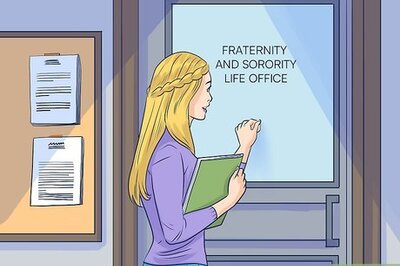
views
Given the vigour with which the Aam Aadmi Party (AAP) is pushing for an alliance with the Congress in Delhi, one may finally witness some kind of an arrangement, if not an alliance, between the two parties.
During her sojourn in the capital recently for an opposition dharna, Trinamool Congress supremo and West Bengal Chief Minister Mamata Banerjee had said that the AAP wanted to have an alliance, but the Congress was yet to respond.
In a last-ditch attempt, AAP leader and Delhi Chief Minister Arvind Kejriwal even rushed to Puducherry to join a show of solidarity with Congress CM V Narayanasamy against Lieutenant Governor of the Union Territory, Kiran Bedi. Indeed, whole lot of water has flowed in the Yamuna since 2011-12, when Kejriwal, in company with Kiran Bedi, had filed a corruption complaint against the Manmohan Singh-led government, where Narayanasamy was an important minister.
The AAP leader is believed to have even pleaded his case with Nationalist Congress Party (NCP) president Sharad Pawar. The Maratha leader, who is an ally of the Congress in Maharashtra, failed to issue any public advice, as Mamata did. The point to be noted here is that unlike Pawar, Mamata is not an ally of the Congress in West Bengal. Rather, the two work at cross-purposes in state politics.
The question which arises here is what is it that is keeping the Congress away from joining hands with the AAP, which is in power in Delhi, and the former with no presence in the Delhi Assembly. In an ordinary situation, the Congress should have been pleading for an alliance with AAP, but here it’s the other way around.
To understand this emerging situation, one has to comprehend the political structure of the national capital. Following the delimitation of constituencies in 2008, Delhi has seven Lok Sabha constituencies — Chandni Chowk, North-East Delhi, East Delhi, New Delhi, North-West Delhi (Reserve), West Delhi and South Delhi. Each of these constituencies has 10 Assembly seats. Prior to this, the Assembly segments were unevenly distributed with the now-disbanded Outer Delhi seat having 21 Assembly seats and East Delhi seat having 20 Assembly seats, whereas Chandni Chowk had just six and now-disbanded Delhi Sadar had seven.
The change in the shape and size of the constituencies in the national capital, as would be the case anywhere else, have largely been propelled by a change in the demographic profile.
When the first Lok Sabha polls were held in 1952, Delhi had just four seats. All the four seats, except the New Delhi seat, were represented by the Congress. Sucheta Kripalani got elected to the first Lok Sabha from New Delhi as Kishan Majdoor Praja Party candidate. Kriplani later became leader of the Congress legislature party in Uttar Pradesh and was elected as the state’s first woman chief minister.
The contest in the national capital has largely been between the Congress and the BJP, and its forerunner Bharatiya Jana Sangh, till the advent of the AAP in 2013. The voters in the national capital are known to vote decisively, thus the trend of the Congress losing all the Lok Sabha seats in 1999, winning six of the seven in 2004 and all the seven in 2009. In 2014, the BJP won all the seven seats.
The question is where does the AAP fit, or not fit, in the electoral scheme for 2019 Lok Sabha polls, especially when it had won 67 out of the 70 Vidhan Sabha seats in 2015. The Congress strategists are averse to sharing the burden of the anti-incumbency against the Kejriwal government. A lesson learnt the hard way during the Uttar Pradesh assembly polls in 2017, where it had aligned with then ruling Samajwadi Party.
It’s with this idea of using the anti-incumbency both against the Centre and the state governments that the party has pitched for an octogenarian Sheila Dikshit under whose leadership the party won the 1998, 2003 and 2008 assembly polls, and 2004 and 2009 Lok Sabha polls.
In 2015, soon after winning the assembly polls, AAP’s then chief spokesperson Yogendra Yadav had said, “For us, these were local elections of a city assembly, the Prime Minister decided to put it on the national pedestal.”
Probably taking the cue from Yadav, the Congress realises that in 2019 there are going to be national elections and not local polls to the city assembly, thus the reluctance to join hands.
Delhi in the past three decades has undergone a profound demographic change. The migrants arriving in the city, which is North India’s El Dorado, have given a new character to its social and cultural life. From being poor tenants in the unauthorised colonies, the migrants are now proud holders of plots, but have been fighting with the successive governments for their civic rights as recognition of unauthorised colonies still lies in a limbo.
A similar metamorphosis had taken place when the Punjabi refugees had arrived in the national capital in 1947. For four decades, the politics of Delhi was between the Punjabis and the Vaishyas, with both parties having their share of leaders belonging to these communities. In case of the BJP, and the BJS, the presence of the Vaishyas and Punjabis was more pronounced.
Today, the BJP is bereft of any tall Punjabi leader, discounting Arun Jaitley as a Delhi leader. The Vaishyas have the present chief minister from their community, thus their loyalty is divided between the AAP and the BJP. In Manoj Tiwari, the BJP has para-dropped a Purvanchali face, whose acceptability within the rank and file is not beyond him being a good crowd entertainer.
On the other hand, Kejriwal’s party, both in 2015 Assembly elections and 2017 municipal polls, fielded Purvanchali candidates in ample numbers and they delivered too. They are today present in large numbers in both the bodies.
However, from the high tide years of 2014-15, the AAP has been consistently losing its national appeal across the elections and that too at a very fast pace. Thus, the presence of a large number of AAP members in the East Delhi Municipal Corporation and MLAs from East Delhi may not transfer into a vote for their likely candidate Atishi Marlena, who has changed her surname to Singh to meet the demands of an electoral stratagem.
Coming to the Congress, their more than one-term MPs and former party presidents Ajay Maken and JP Agrawal have already started campaigning in their respective formerly represented seats of New Delhi and North-East Delhi. So has their former MP from West Delhi, Mahabal Mishra, who is also the party’s Purvanchal face.
The party, as of now, however, has a problem of natural choice on the other four seats — Chandni Chowk, as senior leader Kapil Sibal, who has represented the seat for 10 years, may opt out; South Delhi, where the absence of local strongman Sajjan Kumar, who is now in jail in the anti-Sikh riot cases, would be greatly felt; East Delhi seat, where the absence of Sandeep Dikshit, the former two-term MP and son of Delhi Congress chief Sheila Dikshit, has set the tongues wagging; and the reserved North-West Delhi seat, from where its former MP Krishna Tirath has migrated to the BJP.
This leaves some scope for a political manoeuvre and the reason why Kejriwal still pushing for an alliance.
(The author is a political commentator. Views are personal)


















Comments
0 comment